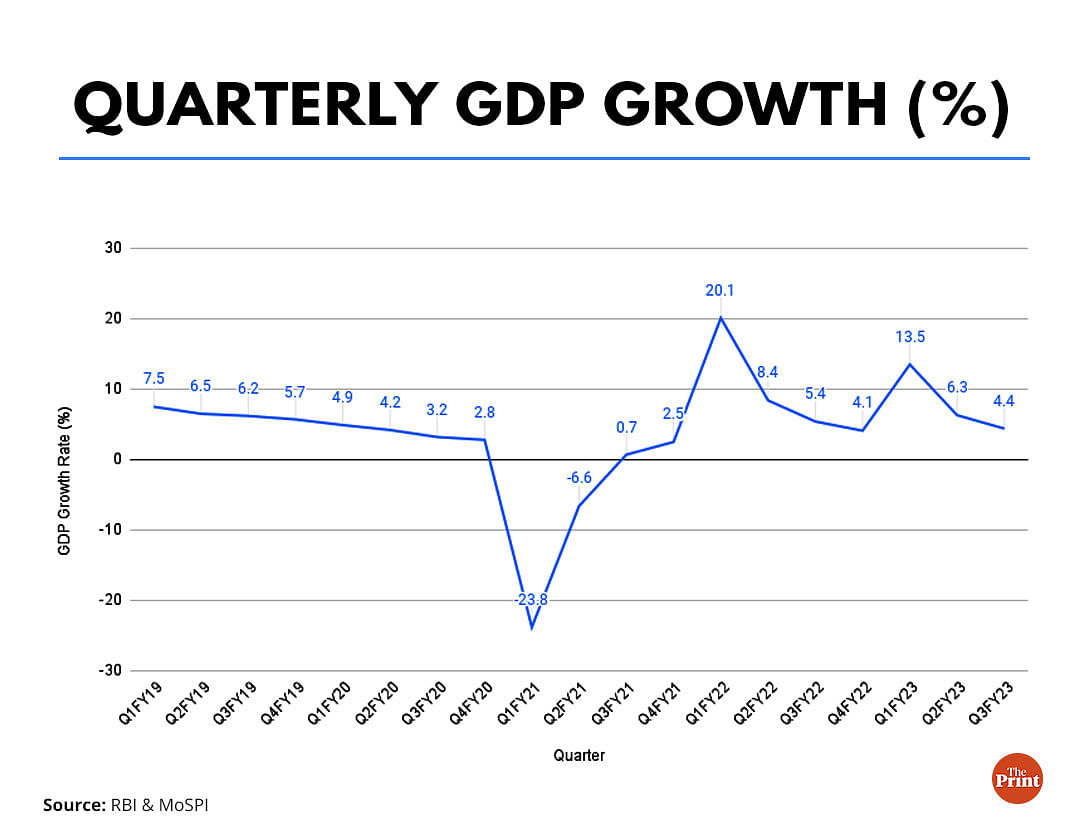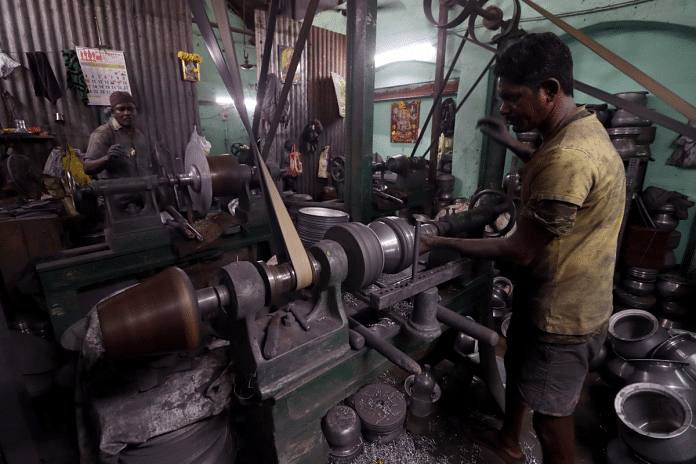New Delhi: The Indian economy is predicted to grow by 7 per cent in financial year 2022-23, according to the government’s second advance estimates of national income released Tuesday, the same as was predicted in the first advance estimates released in early January.
However, the data also shows that GDP growth slowed to 4.4 per cent in the third quarter (October-December 2022) of this financial year. This is the slowest it has been since the January-March 2022 quarter.
The slowing growth in Q3 not only marks the second consecutive quarter of slowing growth (Q2 growth at 6.3 per cent was lower than Q1 growth of 13.5 per cent), but also comes on the back of a low base of 5.4 per cent growth in Q3 of last year. Typically, a low base leads to higher growth levels, but this has not been the case in this quarter.
“The Q3 GDP growth rate at 4.4 per cent is on expected lines,” Ritika Chhabra, Quant Macro Strategist at Prabhudas Lilladher PMS, said. “The loss in growth momentum is due to fading away of favourable base effect, slowdown in pent up demand due to high inflation and interest rates and contraction in manufacturing sectors.”
Some of the high frequency indicators were already pointing at muted growth for the third quarter as compared to the second quarter, she added.

Also Read: 62% industry leaders optimistic about economic growth in 2023, down from 78% last year: Deloitte
Second advance estimates more accurate
The second advance estimates (AE) are a more accurate prediction of growth for the year because they incorporate data for three out of four quarters of the financial year, whereas the first AE are based on data for just two quarters.
“The NSO’s 2nd advance estimate for the FY2023 GDP growth of 7 per cent is unchanged from the 1st AE, despite a downward revision in the growth of consumption, Government Final Consumption Expenditure, Gross Fixed Capital Formation and exports, which is partly explained by the revision for FY2022 as well as a change in discrepancies,” Aditi Nayar, Chief Economist, Head — Research & Outreach, ICRA said.
The 7 per cent growth rate prediction matches the estimates made by Finance Minister Nirmala Sitharaman in 2023-24 Union Budget speech, and also the predictions made in the 2022-23 Economic Survey.
Within the estimates of annual growth, the data shows the manufacturing sector is expected to grow by just 0.6 per cent in the full year, lower than the 1.6 per cent predicted in the first AE.
One of the reasons for this lower prediction for growth in the manufacturing sector is that its growth in the previous year (2021-22) was revised upwards to 11.1 per cent from 9.9 per cent.
The other reason is that the sector contracted 1.1 per cent in Q3 of this financial year, though by a smaller amount than the 3.6 per cent contraction in Q2.
“The major disappointment is negative growth in manufacturing which can be attributed to weak profit & loss (P&L) accounts of this sector,” Madan Sabnavis, Chief Economist at Bank of Baroda said in a note. “The Q2 results did indicate a fall in profits due to high input costs.”
Notably, growth expectations for the agriculture sector were revised downwards to 3.3 per cent in the second AE from the 3.5 per cent predicted in the first AE. Here, too, one of the reasons is that growth in 2021-22 was revised upwards to 3.5 per cent from 3 per cent.
Looking at Q3, the agriculture sector is expected to see growth accelerating to 3.7 per cent, the fastest this financial year (2.4 per cent in Q2 and 2.5 per cent in Q1).
The construction sector — another major employer — is expected to grow at 9.1 per cent in 2022-23 as per the second AE, the same as was predicted in the first AE, despite growth in the previous year being drastically revised upwards to 14.8 per cent from 11.5 per cent.
In Q3, the construction sector grew 8.4 per cent, albeit over a very low base of 0.2 per cent in the same quarter of the previous year.
The real outperformer was the ‘Trade, Hotels, Transport, Communications & services related to Broadcasting’ segment. Growth in these sectors, taken together, is expected to come in at a blistering 14.2 per cent as per the second AE, up from an already rapid growth of 13.7 per cent predicted in the first AE.
Significantly, this strong growth comes on the back of growth in the previous year being revised upwards to 13.8 per cent from the previously predicted 11.1 per cent.
In Q3, these sectors together grew 9.7 per cent over a high base of 9.2 per cent in the same quarter of the previous year. However, this was slower than 15.6 per cent growth in Q2 and 25.7 per cent growth in Q1 of this financial year.
(Edited by Tony Rai)
Also Read: ‘Don’t bet against India’ — CEA Nageswaran vs ex-CEA Subramanian in economy debate



